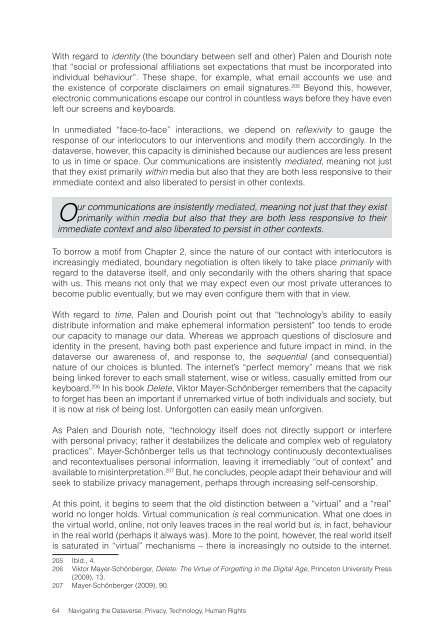Navigating the Dataverse: Privacy, Technology ... - The ICHRP
Navigating the Dataverse: Privacy, Technology ... - The ICHRP
Navigating the Dataverse: Privacy, Technology ... - The ICHRP
You also want an ePaper? Increase the reach of your titles
YUMPU automatically turns print PDFs into web optimized ePapers that Google loves.
With regard to identity (<strong>the</strong> boundary between self and o<strong>the</strong>r) Palen and Dourish note<br />
that “social or professional affiliations set expectations that must be incorporated into<br />
individual behaviour”. <strong>The</strong>se shape, for example, what email accounts we use and<br />
<strong>the</strong> existence of corporate disclaimers on email signatures. 205 Beyond this, however,<br />
electronic communications escape our control in countless ways before <strong>the</strong>y have even<br />
left our screens and keyboards.<br />
In unmediated “face-to-face” interactions, we depend on reflexivity to gauge <strong>the</strong><br />
response of our interlocutors to our interventions and modify <strong>the</strong>m accordingly. In <strong>the</strong><br />
dataverse, however, this capacity is diminished because our audiences are less present<br />
to us in time or space. Our communications are insistently mediated, meaning not just<br />
that <strong>the</strong>y exist primarily within media but also that <strong>the</strong>y are both less responsive to <strong>the</strong>ir<br />
immediate context and also liberated to persist in o<strong>the</strong>r contexts.<br />
Our communications are insistently mediated, meaning not just that <strong>the</strong>y exist<br />
primarily within media but also that <strong>the</strong>y are both less responsive to <strong>the</strong>ir<br />
immediate context and also liberated to persist in o<strong>the</strong>r contexts.<br />
To borrow a motif from Chapter 2, since <strong>the</strong> nature of our contact with interlocutors is<br />
increasingly mediated, boundary negotiation is often likely to take place primarily with<br />
regard to <strong>the</strong> dataverse itself, and only secondarily with <strong>the</strong> o<strong>the</strong>rs sharing that space<br />
with us. This means not only that we may expect even our most private utterances to<br />
become public eventually, but we may even configure <strong>the</strong>m with that in view.<br />
With regard to time, Palen and Dourish point out that “technology’s ability to easily<br />
distribute information and make ephemeral information persistent” too tends to erode<br />
our capacity to manage our data. Whereas we approach questions of disclosure and<br />
identity in <strong>the</strong> present, having both past experience and future impact in mind, in <strong>the</strong><br />
dataverse our awareness of, and response to, <strong>the</strong> sequential (and consequential)<br />
nature of our choices is blunted. <strong>The</strong> internet’s “perfect memory” means that we risk<br />
being linked forever to each small statement, wise or witless, casually emitted from our<br />
keyboard. 206 In his book Delete, Viktor Mayer-Schönberger remembers that <strong>the</strong> capacity<br />
to forget has been an important if unremarked virtue of both individuals and society, but<br />
it is now at risk of being lost. Unforgotten can easily mean unforgiven.<br />
As Palen and Dourish note, “technology itself does not directly support or interfere<br />
with personal privacy; ra<strong>the</strong>r it destabilizes <strong>the</strong> delicate and complex web of regulatory<br />
practices”. Mayer-Schönberger tells us that technology continuously decontextualises<br />
and recontextualises personal information, leaving it irremediably “out of context” and<br />
available to misinterpretation. 207 But, he concludes, people adapt <strong>the</strong>ir behaviour and will<br />
seek to stabilize privacy management, perhaps through increasing self-censorship.<br />
At this point, it begins to seem that <strong>the</strong> old distinction between a “virtual” and a “real”<br />
world no longer holds. Virtual communication is real communication. What one does in<br />
<strong>the</strong> virtual world, online, not only leaves traces in <strong>the</strong> real world but is, in fact, behaviour<br />
in <strong>the</strong> real world (perhaps it always was). More to <strong>the</strong> point, however, <strong>the</strong> real world itself<br />
is saturated in “virtual” mechanisms – <strong>the</strong>re is increasingly no outside to <strong>the</strong> internet.<br />
205 Ibid., 4.<br />
206 Viktor Mayer-Schönberger, Delete: <strong>The</strong> Virtue of Forgetting in <strong>the</strong> Digital Age, Princeton University Press<br />
(2009), 13.<br />
207 Mayer-Schönberger (2009), 90.<br />
64 <strong>Navigating</strong> <strong>the</strong> <strong>Dataverse</strong>: <strong>Privacy</strong>, <strong>Technology</strong>, Human Rights
















